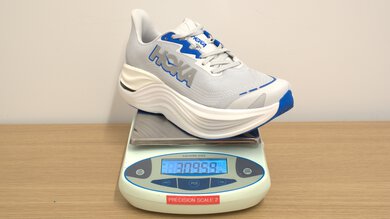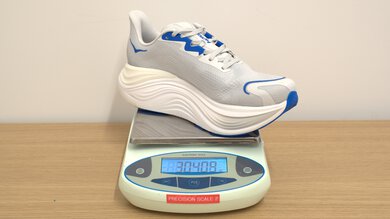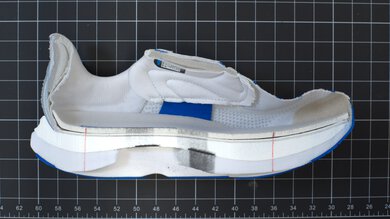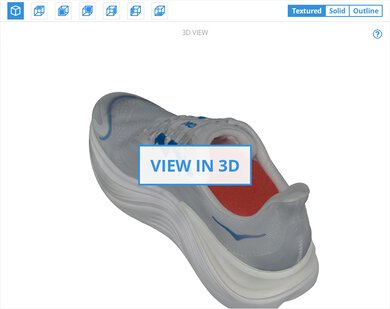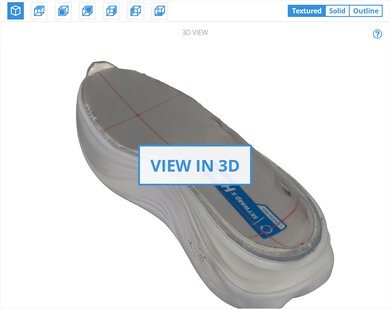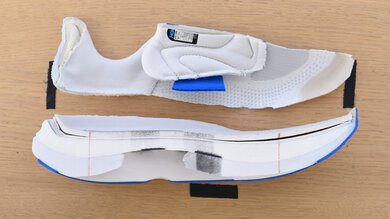The HOKA Skyward X is a max-cushioned running shoe that promises comfort, stability, and a smooth ride for long-distance training. Featuring a combination of PEBA and EVA foam, along with a convex H-shaped carbon plate, this staggeringly tall shoe delivers a plush yet controlled experience. It's built for those who prefer an ultra-high stack height for their easy sessions, and it provides a smooth heel-to-toe transition. However, the shoe is quite heavy compared to most super trainers.
Our Verdict
The HOKA Skyward X offers adequate performance for marathon racing, with great cushioning and decent energy return. This could make for quite a comfortable marathon for heavier runners looking for a protective plated shoe, though it may not be the best choice for competitive runners looking for a lighter, more responsive shoe.
-
Amazing forefoot cushioning.
-
EVA-PEBA mix balances energy return and cushioning well.
-
Really heavy.
-
Not as responsive as other marathon racers.
The HOKA Skyward X is suitable for shorter races but will feel heavy and less agile compared to lighter racing shoes. It could provide decent performance for casual runners, but its bulkiness would make it far from ideal. The soft foam in the forefoot will also make it feel less dynamic than true super shoes.
-
EVA-PEBA mix balances energy return and cushioning well.
-
Really heavy.
-
Foam isn't firm underfoot.
The HOKA Skyward X features decent energy return thanks to its premium PEBA-based foam in the top layer. This foam absorbs and returns a satisfactory amount of energy, creating a bouncy and lively underfoot feel—though it's slightly firmer than some other PEBA formulations. However, this energetic ride is somewhat muted by the shoe's overall weight and construction, which dampens the full potential of the foam's responsiveness.
-
EVA-PEBA mix balances energy return and cushioning well.
-
The bulky build dulls the ride's potential.
The HOKA Skyward X is impressively cushioned, providing a plush and comfortable ride. This makes it suitable for long-distance training and recovery runs, offering a soft and protective underfoot feel when fatigue sets in.
-
Amazing forefoot cushioning.
-
EVA-PEBA mix balances energy return and cushioning well.
The HOKA Skyward X offers decent lateral stability. It has a wide base and an H-shaped carbon plate to hold the two layers of foam together. However, its towering stack height and soft foam underfoot prevent it from being truly stable, making it only moderately secure, especially when the form begins to break down or during sharp turns.
-
Very wide outsole.
-
EVA-PEBA mix balances energy return and cushioning well.
-
Foam isn't firm underfoot.
-
Exaggerated stack height.
- 6.8 Marathon Racing
- 6.0 5K/10K Racing
Performance Usages
- 7.4 Energy Return
- 8.3 Cushioning
- 7.3 Lateral Stability
Changelog
- Updated Apr 02, 2025: Converted to Test Bench 0.8.
- Updated Apr 02, 2025: Review published.
Differences Between Sizes And Variants
We tested the HOKA Skyward X in men's US size 9, as indicated on the label. The colors shown here are Cosmic Grey & Silver. This model currently comes in two additional colorways for men (Luna Moth/Black and Blanc de Blanc/Virtual Blue) and three additional colorways for women, including Cosmic Grey/Rose Gold, Lemonade/Sunlight, and Blanc de Blanc/Swim Day. Wide versions are not available for this model. The design section applies only to the exact model we tested, but we expect other size and gender variants to perform similarly.
Compared To Other Running Shoes
The HOKA Skyward X defies traditional running shoe categories, blending elements rarely found in a trainer, such as a PEBA-EVA mix foam and a convex carbon plate. However, these high-tech features don't make it a super trainer, and even less so a racing shoe. Instead, this shoe is best suited for runners who appreciate extreme stack heights and want a premium, maximalist option for daily training, particularly for recovery runs where underfoot protection is key. If you're looking for more premium trainer options, check out the Mizuno Neo Vista and Brooks Glycerin Max.
Within HOKA's lineup, the HOKA Mach X and HOKA Mach X 2 fit more into the classic super trainer mold, offering a lighter, more energetic ride with greater stability. The Mach X 2 is even more cushioned than the Skyward X, proving that you don't necessarily need the highest stack height to get better cushioning. For runners seeking a carbon-plated shoe for speed work or racing, the HOKA Cielo X1 2.0 would be a far better choice.
For more options, check out our recommendations for the best running shoes to find the perfect pair.
The HOKA Skyward X and the Brooks Glycerin Max are both ultra-high-stack, max-cushioned trainers, but they take different approaches to achieving comfort and performance. The HOKA is the more cushioned of the two, offering an even softer and more protective ride while providing significantly more energy return—something the Brooks shoe lacks entirely. Additionally, the HOKA is noticeably more stable, making it more versatile. The Brooks, while slightly lighter, is a straightforward, no-fuss max-cushioned trainer that excels at one thing: providing soft, consistent comfort for easy runs. Also, while both shoes have substantial stack heights, the Brooks' stack is less exaggerated, making it feel a bit more traditional.
The HOKA Skyward X and HOKA Clifton 9 are both high-stack, cushioned running shoes, yet they cater to different preferences and training needs. The Clifton 9 is lighter and offers superior lateral stability, partly due to its substantial yet lower stack height compared to the Skyward X. This design provides a more grounded feel and makes it suitable for runners seeking a stable daily trainer. In contrast, the Skyward X delivers more cushioning and significantly higher energy return, making for a more dynamic running experience.
The HOKA Skyward X and HOKA Mach X are both premium trainers, but they cater to different types of runners. The Skyward X is all about maximum cushioning and underfoot protection, making it a great option for recovery runs or those who prefer an ultra-soft, high-stack experience. However, its towering design doesn't translate into a particularly energetic ride. The Mach X, on the other hand, fits more into the super trainer category. It's significantly lighter, more stable, and delivers a snappier feel underfoot. While both shoes incorporate advanced foam blends, the Mach X offers a more versatile ride that works well for both daily miles and uptempo efforts.
The HOKA Skyward X and the HOKA Mach X 2 both sit in the high-cushion performance trainer category, but their execution differs. The Skyward X prioritizes plush comfort with an extreme stack height and carbon plate, making it feel more like a max-cushioned cruiser than a performance shoe. The Mach X 2, on the other hand, refines the formula of its predecessor, offering an even more cushioned ride but with better energy return and a more natural transition. Despite its slightly increased cushioning, the Mach X 2 remains lighter and more stable than the Skyward X, making it a stronger choice for those who want a dynamic yet comfortable daily trainer. The Skyward X works best for easy runs where protection is key, while the Mach X 2 offers more versatility across different paces and workouts.
Test Results
This shoe is on the heavier side, which is one of its main drawbacks. The added weight makes it feel less agile than super trainers like the HOKA Mach X 2.
The heel of this shoe offers decent energy return, primarily due to the PEBA-based foam in the top layer. Heel strikers will experience this bounciness, but the energy return isn't as pronounced as in lighter, more aggressive racing models like the adidas Adizero Adios Pro 3.
The forefoot delivers good energy return. The foam decompresses well under force, offering a noticeable bounce that benefits forefoot strikers looking for a responsive ride.
This shoe is very cushioned at the heel, offering a plush experience. It absorbs impact really well, compressing smoothly to deliver a forgiving ride. This cushioning, combined with the shoe's towering stack height, provides a very comfortable ride, perfect for easy miles and long runs.
The forefoot cushioning is excellent, providing a well-cushioned and squishy feel. The high level of energy absorption ensures a soft underfoot experience, making each stride feel smooth and protective.
The HOKA Skyward X is generally not very firm in the heel. However, due to the shoe's structure, forefoot strikers might perceive it as quite firm. Midfoot and heel strikers, on the other hand, are less likely to find it rigid, as the cushioning allows for a softer, more forgiving landing.
While the forefoot isn't very firm overall, lighter or smaller runners may still find it fairly firm. The shoe's softness becomes more noticeable when greater force is applied, meaning heavier runners will experience more softness, while lighter runners might still perceive some rigidity.
Comments
HOKA Skyward X: Main Discussion
Let us know why you want us to review the product here, or encourage others to vote for this product.


